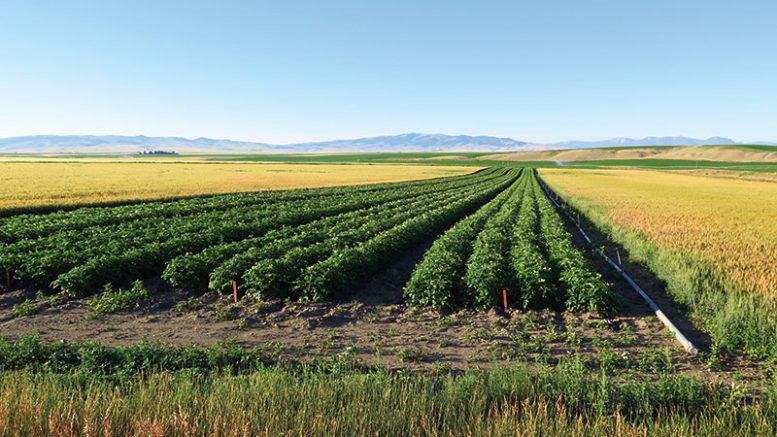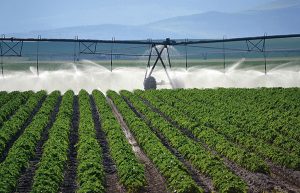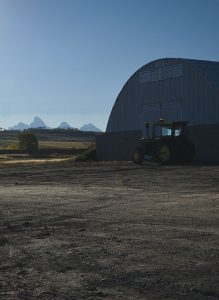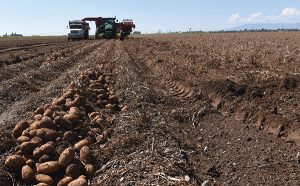Montana Seed Potato Crop
By Nina Zidack, Montana Seed Potato Certification
Montana seed potato acreage was up slightly to 10,355 acres in 2018, compared to 10,220 acres in 2017. Russet Burbank is still the dominant variety, holding steady at 3,921 acres. Clearwater Russet acreage continues to rise dramatically with 1,016 acres in 2018 compared to 698 the previous year, representing a 31 percent increase. Umatilla Russet is the second most widely produced variety in Montana, but was down 16 percent from 1,789 acres in 2017 to 1,509 acres in 2018. Ranger Russet acreage is steady at 1,172 acres, and the Russet Norkotah selections increased by 13 percent to 997 acres. Alturas continues to decline from 637 acres in 2017 to 588 acres in 2018. Standard Norkotah acreage dropped precipitously and now only accounts for 54 acres in Montana. There are a total of 57 varieties of potatoes registered for certification.
2018 was a year of early extremes followed by warm, mild conditions. Some Montana growers were planting in early May, and some got a late start due to wet conditions in mid-May, finishing planting in early June. In the Gallatin and Beaverhead areas, the early planted potatoes received a hard frost on June 12, and the later planted potatoes ended up staging very similar to the earlier planted potatoes. The rest of the summer had ideal growing conditions throughout the state with plenty of warm days but no extreme heat or storms. This set up the Montana crop for strong yields of extremely uniform tubers and an optimal size profile.
In Montana, production of seed with very low virus levels is enhanced by growers’ practice of planting all Generation I potatoes as family units. Each unit is planted with the daughter tubers from a single nuclear generation plant. During the summer, each unit is 100 percent tested for Potato virus Y (PVY). If a test comes back positive, the whole unit is removed. In addition to PVY, the state tests for PVX and PVA in the winter grow-out planted in November on the island of Oahu, Hawaii.
Washington Seed Potato Crop
By Jeff Bedlington, Washington State Seed Potato Commission
Ideal spring weather brought excellent spring tillage and planting conditions. This allowed Washington’s seed potato crop to get off to a good start with early emergence and good stands. Planted acres remained constant at 3,681 acres, with slight increases of specialty and proprietary varieties.
A warmer, drier summer resulted in minimal disease pressure and no significant late blight detections. This allowed growers to continue with preventative sprays and focus on irrigation. Foliage growth and plant health was exceptional.
Fall harvest began earlier than in 2017. It was interrupted with some rain showers, but wrapped up at the beginning of November. Overall crop quality is excellent, with yields average to slightly above average.
The majority of the crop is contracted, but growers expect a strong demand for any remaining high quality seed. Post-harvest testing is conducted as a winter grow-out beginning in November, with results to follow in January.
Oregon Seed Potato Crop
By Jeff McMorran, Oregon Seed Certification Service
The Oregon Seed Certification Service (OSCS) had a fairly average year in 2018, accepting 2,842 acres of seed potatoes for certification. This was a slight decrease from 2017 when 3,181 acres were certified. Most of the reduction in acreage can be attributed to a decrease in organic potato seed production in northeast Oregon, as well as the retirement of longtime central Oregon producer Jim Carlson. We continued to see increases in the north-central area of the state.
The yellow-skinned, yellow-fleshed variety Gala was the number one variety certified in Oregon in 2018 with 462 acres, followed by an assortment of Frito-Lay varieties at 327 acres. Specialty red- and yellow-fleshed varieties continue to gain a foothold in Oregon seed production areas; however, russet white-fleshed varieties for processing or fresh market still made up the bulk of the rest of Oregon production in 2018. A complete listing of the varieties and acres produced in Oregon can be found at www.seedcert.oregonstate.edu/potatoes.
Summer field readings for disease were low. None of the acres entered for certification were downgraded or rejected due to disease or off-type (as per the field inspections). Blackleg and white mold levels were considerably lower than previous years, and mosaic levels remained low.
Heavy smoke continued to blanket much of our growing areas again in 2018. Growers reported that the smoke tended to slow down bulking rates, but did not seem to affect the number of tubers produced. In some cases, this improved the sizing profile of the seed, which helped satisfy contracts, even though yields may have been reduced somewhat.
Harvest wrapped up in early November. Tuber quality seems to be above average with few internal issues. The post-harvest winter grow-out has begun. This year, OSCS is conducting all its grow-outs in trays in the greenhouse rather than direct planting into the greenhouse soil. This should speed up the process and get results back to growers earlier. It will also help avoid areas of the greenhouse where slow emergence has been a problem in previous years.
Idaho Seed Potato Crop
By Alan Westra, Idaho Crop Improvement Association
Many Idaho seed growers had a difficult planting season with significant delays due to rain. As a result, yield reports are mixed with some growers reporting average to good yields, while others are reporting lower than average yields. Quality going into storage is reported as good to excellent. Overall, the 2018 crop had a higher set than normal and appears to have a very nice size profile. Seed health appears to be steady from 2017. The number of seed lots with visually detectable levels of Potato virus Y (PVY) decreased slightly compared to 2017. There were no bacterial ring rot detections during field inspections.
Seed availability is predicted to be impacted by not only an overall lower to average yield, but also by a significant reduction in certified seed acreage. At the conclusion of the second round of field inspections, a total of 29,295 acres are eligible for final certification in 2018. This is down approximately 10 percent from 2017.
Excluding proprietary genetics, the 2018 acreage accepted for certification represents a total of 149 varieties, selections and advanced clones. For 2018, the top varieties were Russet Burbank (41 percent of total acreage accepted), Russet Norkotah (all strains, 18 percent), Ranger Russet (12 percent), Clearwater Russet (4 percent), Alturas (3 percent) and Umatilla Russet (3 percent). Seed acreage of Russet Burbank, Russet Norkotah and Alturas is off approximately 7 percent compared to 2017. Clearwater Russet acreage increased by 3 percent, while there was a 15 percent reduction in Umatilla Russet acreage compared to 2017. A complete listing of the seed potato crop is available in the 2018 Idaho Certified Seed Potato Directory, posted on the Idaho Crop Improvement website at www.idahocrop.com.
Colorado Seed Potato Crop
By Andrew Houser, Colorado Potato Certification Service
2018 was a very unique year as far as weather goes in the San Luis Valley in south central Colorado, where most of the state’s potatoes are grown. In typical years, winter temperatures can drop to 20 or 30 below zero. This past winter, temperatures rarely dropped below zero. This was in large part due to lack of snowpack in the surrounding mountain ranges. The warm temperatures continued through May and June, resulting in a fast growing potato crop.
Harvest of the potato acreage in the San Luis Valley wrapped up at the end of October. Overall, yields have been above average, due in part to the warm weather in the summer. Certified seed growers have already submitted seed lot samples for the post-harvest test, which takes place at the North Shore of Oahu, Hawaii. An official 2018 certified seed directory is posted online at http://potatoes.colostate.edu/potato-certification-service, and an interactive version is available at www.coloradocertifiedpotatogrowers.com.
In 2018, Colorado certified seed potato acreage was up overall from 10,093 acres in 2017 to 10,282 acres in 2018 (1,469 of these acres qualify for grower plant-back only). The total accepted certified acreage after summer field inspections was 9,306 acres. Rejections were primarily the result of Potato virus Y (PVY)/mosaic, with a few rejections caused by blackleg and variety mix. The 2018 top five certified potato varieties in Colorado are Russet Norkotah selections, Canela Russet, Centennial Russet, Teton Russet and Lamoka.
The Colorado Seed Act requires all seed lots imported into Colorado to undergo a post-harvest test or winter grow-out. A PVYN tolerance of 1 percent is in place for all seed coming into Colorado. Also, there is a late blight quarantine in effect for all seed coming into the San Luis Valley. This test needs to be conducted by a qualified lab prior to shipment. For testing specifics, visit http://potatoes.colostate.edu/wp-content/uploads/2014/02/Late-Blight-Quar-2014.pdf.






